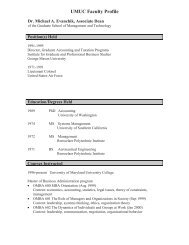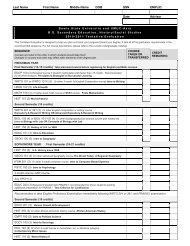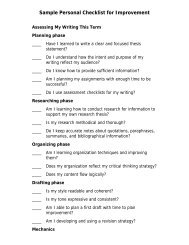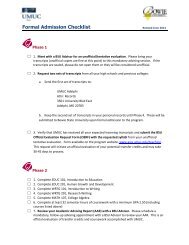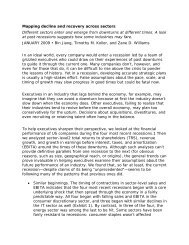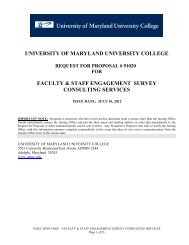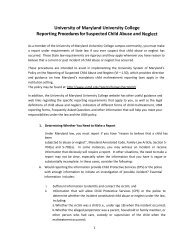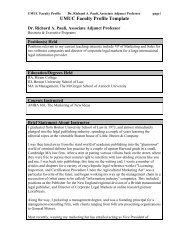COURSE DESCRIPTIONSBIFS (Bioinformatics)BIFS 613 Statistical Processes for Biotechnology (3)(Formerly BIOT 613.) Prerequisite: Knowledge <strong>of</strong> basic statistics.A study <strong>of</strong> statistical tools—such as Bayesian statistics, Markovprocesses, and information theoric indices—and how they canbe used to analyze sequence homology, the presence <strong>of</strong> motifs insequences, gene expression, and gene regulation. Topics includeinformation content, mutual information, long-range correlation,repeats, Fourier analysis, and linguistic methods.BIFS 614 Data Structures and Algorithms (3)(Formerly CSMN 614.) An introduction to the definitions, implementations,and applications <strong>of</strong> the most basic data structures used incomputer science, including abstract data types. Basic formalism andconcepts used in algorithm design and the analysis <strong>of</strong> algorithms arealso introduced. The relative efficiency <strong>of</strong> the algorithms studied isestimated by informal application <strong>of</strong> these concepts. Algorithms anddata structures discussed include those for sorting, searching, solvinggraph problems, and dynamic programming.BIFS 617 Advanced Bioinformatics (3)(Formerly BIOT 617.) An overview <strong>of</strong> the basic programmingtools for performing bioinformatic analyses in both the UNIXand MS DOS/Window environments. Focus is on the use <strong>of</strong>Perl and BioPerl as the basic programming tools. Basic programmingskills are developed and practiced on such problems as codonusage/bias, open reading frame, CpG islands detection, and geneidentification.BIFS 618 Java for Biotechnology Applications (3)A study <strong>of</strong> basic concepts in Java and object-oriented programmingin bioinformatics application development. Emphasis is on Webbased,graphical, and database-driven application design. Reviewcovers the function and design <strong>of</strong> some Java-based bioinformaticstools. Some commonly used libraries in the BioJava project areintroduced, and developments <strong>of</strong> reusable modular-applicationobjects are examined. Basic problem-solving skills in the field <strong>of</strong>biotechnology using Java programming are developed throughpractical projects.BIFS 619 Gene Expression Data Analysis (3)A study <strong>of</strong> high-throughput technologies for transcriptome andgenomic aberration pr<strong>of</strong>iling. Topics include statistical theories, algorithmsand data analysis tools for microarray experiments, array comparativegenome hybridization, SNP array experiments, and supervisedand unsupervised machine learning technologies for class discoveryand classifier identifications. Practice is provided in the preprocess<strong>of</strong> empirical gene expression pr<strong>of</strong>iling and the postprocess <strong>of</strong>microarray data analysis for identifying differentially regulated genesrelated to biological functions. Several legacy databases and data integrationstrategies in gene expression pr<strong>of</strong>iling are explored throughdata mining and functional annotation <strong>of</strong> interesting genes; statisticalprinciples and theories are illustrated.BIOT (Biotechnology Studies)BIOT 601 Molecular Biology for Business Managers (3)A thorough grounding in the fundamentals <strong>of</strong> biology, includinga broad review <strong>of</strong> the life sciences with emphasis on molecular biology.Topics include the basic concepts and processes <strong>of</strong> cell biology,molecular biology, and immunology. The components <strong>of</strong> a cell, theprocesses occurring in a single cell, and the functioning <strong>of</strong> a multicellularorganism are explained. Discussion also covers the use <strong>of</strong>model organisms to understand basic and applied biology.BIOT 630 Introduction to Bioinformatics (3)(Formerly BIOT 610.) An introduction to bioinformatics.Emphasis is on the interpretation <strong>of</strong> data. Topics include new,sophisticated DNA, RNA, and protein sequence analyses andpattern recognition and DNA computing, as well as more traditionalmathematical modeling (using Bayesian probability andbasic algorithms, machine learning and neural networks, andMarkov models and dynamic programming). Discussion alsocovers the analysis <strong>of</strong> tridimensional structures, phylogenicrelationships, and genomic and proteomic data.BIOT 640 Societal Issues in Biotechnology (3)An examination <strong>of</strong> current societal issues in biotechnology fromseveral perspectives. Topics include the commercialization <strong>of</strong> biotechnology;biohazards; managerial views <strong>of</strong> legal issues and bioethics;the need for public scrutiny; environmental and culturalissues; and the role <strong>of</strong> governmental regulatory agencies in researching,developing, and commercializing biotechnology. An overview<strong>of</strong> the early history and modern developments <strong>of</strong> biotechnologyis provided.74GRADUATE <strong>CATALOG</strong> | 2008–2009
BIOT 643 Techniques <strong>of</strong> Biotechnology (3)(Formerly BTMN 643.) A comprehensive review <strong>of</strong> current techniquesin biotechnology research and applications. The developmentand use <strong>of</strong> some <strong>of</strong> the techniques are placed in historicalcontext. Discussion covers techniques used in genomics, transcriptomics,and proteomics and the applications <strong>of</strong> these techniques.Current plant and animal transformation methods are explained.High throughput technologies, including sequencing, real-timeRT-PCR, SAGE, and microarrays, are also explored. Topics alsoinclude therapeutic applications <strong>of</strong> biotechnology, such as genetherapy, stem cell technology, and RNA interference. Emergingtechnologies in this field are introduced.BIOT 645 The Business <strong>of</strong> Biotechnology (3)(Formerly BTMN 645.) An introduction to the range <strong>of</strong> businessesassociated with biotechnology, including medical procedures, selftestingprocedures, pharmaceuticals, reagents, agricultural, environmentalbioremediation, energy production, material and mineralrecovery, veterinary medicine, and sensors. Discussion covers variousalliances and funding sources, as well as global and internationalissues.BSBD (Biosecurity and Biodefense)BSBD 640 Agents <strong>of</strong> Bioterrorism (3)An examination <strong>of</strong> the probable weapons <strong>of</strong> biowarfare, includingbiological, chemical, and nuclear weapons, from several perspectives.Topics include their mechanism <strong>of</strong> action, biological impact, detectionand recognition, epidemiology, and treatment. Their potentialdangers and effectiveness are evaluated, and strategies for defenseagainst attacks by such weapons are investigated. Discussion coversthe bioethical challenges <strong>of</strong> anti-bioterror research.BSBD 641 Biosecurity and Bioterrorism (3)(Formerly BIOT 681.) A review <strong>of</strong> bioterrorism, biosecurity, andgovernment biodefense strategy, including the history and science<strong>of</strong> biological agents in agriculture and society. Discussion coverssurveillance; public health preparedness; response; and recoveryat the community, state, and federal government levels. Variousaspects <strong>of</strong> the law, including the Posse Comitatus Act and federaland state quarantine powers, are introduced. The mental healthconsequences <strong>of</strong> bioterrorism are also discussed. A case study <strong>of</strong>a hypothetical biological attack is analyzed in detail.BSBD 642 Advanced Biosecurity and Bioterrorism (3)(Formerly BIOT 683.) Prerequisite: BIOT 681 or BSBD 641. Athorough examination <strong>of</strong> special and advanced topics in bioterroismand biosecurity issues. Topics include the hidden biological warfareprograms <strong>of</strong> the 20th century; advances in biotechnology and molecularmicrobiology and the dilemma <strong>of</strong> dual use research; domesticand foreign terrorist groups, including rogue states; state-<strong>of</strong>-the-artmicrobial forensics; ethics and civil rights; and current trends inpolicy development, consequence management, and public healthresponses to new threats to homeland security. Discussion alsoaddresses special topics <strong>of</strong> the students’ choice. Future challengesin biosecurity are also discussed as part <strong>of</strong> a comprehensive bioterrorismexercise and the analysis <strong>of</strong> case studies <strong>of</strong> hypothetical threats.BTMN (Biotechnology Management)BTMN 632 Commercializing Biotechnologyin Early-Stage Ventures (3)(Formerly BIOT 641.) An overview <strong>of</strong> the methods for planningand organizing biotechnology ventures. The elements <strong>of</strong> a businessplan are considered, as are methods for assessing various needs,such as capital, personnel, technology, and marketing. Emphasis ison approaches to marketing technology and developing joint ventures.The advantages and disadvantages <strong>of</strong> forming internationalventures are weighed. Discussion also covers the importance <strong>of</strong>maintaining relations with external constituents and the need formanaging public awareness.BTMN 634 Selection and Evaluation<strong>of</strong> Biotechnology Projects (3)(Formerly BIOT 642.) A study <strong>of</strong> the applications <strong>of</strong> methodologies<strong>of</strong> technology forecasting, technology assessment, projectmanagement, and data auditing to the selection and evaluation<strong>of</strong> biotechnology projects. The underlying rationale, principles,procedures, and cost effectiveness <strong>of</strong> data auditing are examined.A systems approach to performance evaluation is presented.Emphasis is on managing the safety aspects <strong>of</strong> biotechnology.BTMN 636 Biotechnology and the Regulatory Environment (3)(Formerly BIOT 644.) A comprehensive review <strong>of</strong> the role <strong>of</strong>regulation in biotechnology products and services developmentand commercialization. Emphasis is on the roles <strong>of</strong> the federalgovernment, state government agencies, international bodies,and pr<strong>of</strong>essional groups, especially the regulatory roles <strong>of</strong> theU.S. Environmental Protection Agency, the U.S. Department <strong>of</strong>Agriculture, and the Food and Drug Administration. Discussioncovers human subject protection, good laboratory practices, andgood manufacturing practices.www.umuc.edu/grad 75
- Page 1 and 2:
GraduateSchool ofManagement& Techno
- Page 4 and 5:
Table of Contents457INTRODUCTION4 W
- Page 6 and 7:
Welcome to UMUCA UNIQUE INSTITUTION
- Page 8 and 9:
Preparing for Graduate StudyAs most
- Page 10 and 11:
Program OverviewDOCTORAL PROGRAMDoc
- Page 12 and 13:
DOCTORAL DEGREE PROGRAMDOCTOR OF MA
- Page 14 and 15:
MASTER’S DEGREE ANDCERTIFICATE PR
- Page 16 and 17:
MASTER’S DEGREE ANDCERTIFICATE PR
- Page 18 and 19:
MASTER’S DEGREE ANDCERTIFICATE PR
- Page 20 and 21:
MASTER’S DEGREE ANDCERTIFICATE PR
- Page 22 and 23:
MASTER’S DEGREE ANDCERTIFICATE PR
- Page 24 and 25:
MASTER’S DEGREE ANDCERTIFICATE PR
- Page 26 and 27: MASTER’S DEGREE ANDCERTIFICATE PR
- Page 28 and 29: MASTER’S DEGREE ANDCERTIFICATE PR
- Page 30 and 31: MASTER’S DEGREE ANDCERTIFICATE PR
- Page 32 and 33: MASTER’S DEGREE ANDCERTIFICATE PR
- Page 34 and 35: MASTER’S DEGREE ANDCERTIFICATE PR
- Page 36 and 37: MASTER’S DEGREE ANDCERTIFICATE PR
- Page 38 and 39: MASTER’S DEGREE ANDCERTIFICATE PR
- Page 40 and 41: MASTER’S DEGREE ANDCERTIFICATE PR
- Page 42 and 43: MASTER’S DEGREE ANDCERTIFICATE PR
- Page 44 and 45: MASTER’S DEGREE ANDCERTIFICATE PR
- Page 46 and 47: MASTER’S DEGREE ANDCERTIFICATE PR
- Page 48 and 49: MASTER’S DEGREE ANDCERTIFICATE PR
- Page 50 and 51: MASTER’S DEGREE ANDCERTIFICATE PR
- Page 52 and 53: MASTER’S DEGREE ANDCERTIFICATE PR
- Page 54 and 55: MASTER’S DEGREE ANDCERTIFICATE PR
- Page 56 and 57: EXECUTIVE PROGRAMSEver sharper comp
- Page 58 and 59: EXECUTIVE PROGRAMSCHIEF INFORMATION
- Page 60 and 61: DUAL DEGREE PROGRAMSMASTER OF BUSIN
- Page 62 and 63: DUAL DEGREE PROGRAMSMASTER OF BUSIN
- Page 64 and 65: DUAL DEGREE PROGRAMSNonprofit and A
- Page 66 and 67: DUAL DEGREE PROGRAMSMASTER OF DISTA
- Page 68 and 69: DUAL DEGREE PROGRAMSMASTER OF SCIEN
- Page 70 and 71: NONDEGREE TEACHEREDUCATION PROGRAMS
- Page 72 and 73: COURSE DESCRIPTIONSACCT (Accounting
- Page 74 and 75: COURSE DESCRIPTIONSAMBA 605 Economi
- Page 78 and 79: COURSE DESCRIPTIONSBTMN 670 Capston
- Page 80 and 81: COURSE DESCRIPTIONSDEPM (Distance E
- Page 82 and 83: COURSE DESCRIPTIONSDMGT (Doctoral S
- Page 84 and 85: COURSE DESCRIPTIONSEBUS 640 E-Techn
- Page 86 and 87: COURSE DESCRIPTIONSEDTC 620 Technol
- Page 88 and 89: COURSE DESCRIPTIONSEMBA 640 Strateg
- Page 90 and 91: COURSE DESCRIPTIONSENVM 670 Seminar
- Page 92 and 93: COURSE DESCRIPTIONSHCAD 630 Public
- Page 94 and 95: COURSE DESCRIPTIONSHSMN (Homeland S
- Page 96 and 97: COURSE DESCRIPTIONSINFA (Informatio
- Page 98 and 99: COURSE DESCRIPTIONSITEC 640 Informa
- Page 100 and 101: COURSE DESCRIPTIONSMRKT 606 Integra
- Page 102 and 103: COURSE DESCRIPTIONSOMDE 606 Costs a
- Page 104 and 105: COURSE DESCRIPTIONSPMAN 637 Project
- Page 106 and 107: COURSE DESCRIPTIONSSWEN 646 Softwar
- Page 108 and 109: COURSE DESCRIPTIONSTMAN 625 Economi
- Page 110 and 111: ADMINISTRATIONUniversity Systemof M
- Page 112 and 113: ADMINISTRATIONGraduate School ofMan
- Page 114 and 115: CONTACT INFORMATIONMASTER OF INTERN
- Page 116 and 117: CONTACT INFORMATIONOther Important
- Page 118 and 119: ADMISSION AND ENROLLMENT• Proof o
- Page 120 and 121: ADMISSION AND ENROLLMENTFinancial I
- Page 122 and 123: ACADEMIC AND ADMINISTRATIVEREQUIREM
- Page 124 and 125: ACADEMIC AND ADMINISTRATIVEREQUIREM
- Page 126 and 127:
ACADEMIC AND ADMINISTRATIVEREQUIREM
- Page 128 and 129:
SERVICES AND RESOURCESGeneral Infor
- Page 130 and 131:
SERVICES AND RESOURCES• Possess a
- Page 132 and 133:
SERVICES AND RESOURCESVeterans Bene
- Page 134 and 135:
SERVICES AND RESOURCESuate school d
- Page 136 and 137:
FACULTYAwwad, Ahmad A.Adjunct Assis
- Page 138 and 139:
FACULTYBravo, Kathleen M.Adjunct As
- Page 140 and 141:
FACULTYCost, Richard S.Adjunct Assi
- Page 142 and 143:
FACULTYFitzpatrick, Edmund W.Adjunc
- Page 144 and 145:
FACULTYHalstead, John M.Adjunct Ass
- Page 146 and 147:
FACULTYKavoossi, MasoudAdjunct Asso
- Page 148 and 149:
FACULTYMadison, David L.Adjunct Ass
- Page 150 and 151:
FACULTYMustafa, MuhammadAdjunct Pro
- Page 152 and 153:
FACULTYRabin, Bonnie R.Adjunct Prof
- Page 154 and 155:
FACULTYShirani, Ashraf I.Adjunct Pr
- Page 156 and 157:
FACULTYViamonte, GailChair, Teacher
- Page 158 and 159:
UNIVERSITY POLICIESStudent Classifi
- Page 160 and 161:
UNIVERSITY POLICIESReligious Observ
- Page 162 and 163:
UNIVERSITY POLICIESsubsequent semes
- Page 164 and 165:
UNIVERSITY POLICIESV. DisclosuresUM
- Page 166 and 167:
APPENDICESAppendix A: Program-Caree
- Page 168 and 169:
APPENDICESProgram-Career Map, contd
- Page 170 and 171:
APPENDICESProgram-Career Map, contd
- Page 172 and 173:
APPENDICESProgram-Career Map, contd
- Page 174 and 175:
APPENDICESProgram-Career Map, contd
- Page 176 and 177:
APPENDICESProgram—Career Map, con
- Page 178 and 179:
INDEXAAcademic advising, 126Academi
- Page 180 and 181:
INDEXDDatabase systems technologyce
- Page 182 and 183:
INDEXHomeland security managementce
- Page 184 and 185:
INDEXResidency determination, 115,
- Page 186 and 187:
NOTES184GRADUATE CATALOG | 2008-200
- Page 188:
ABOUT UMUCUniversity of Maryland Un





